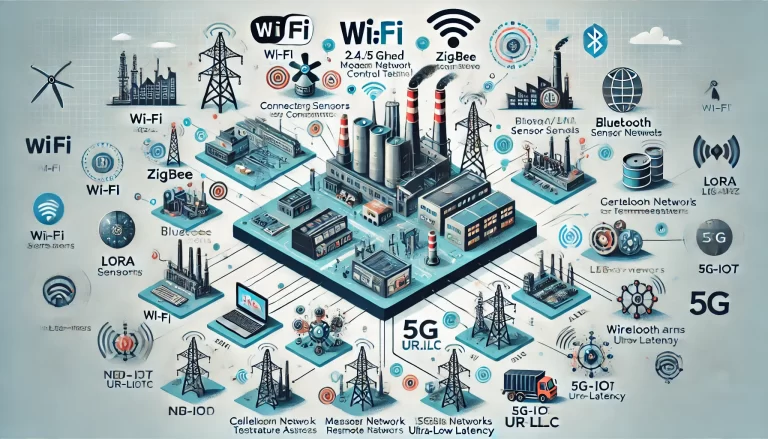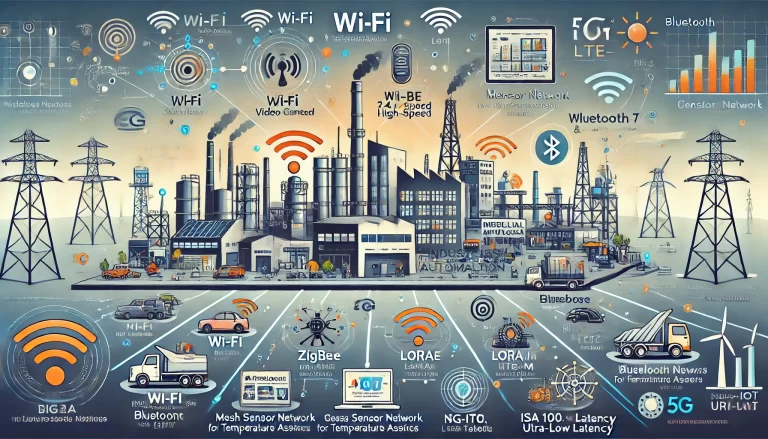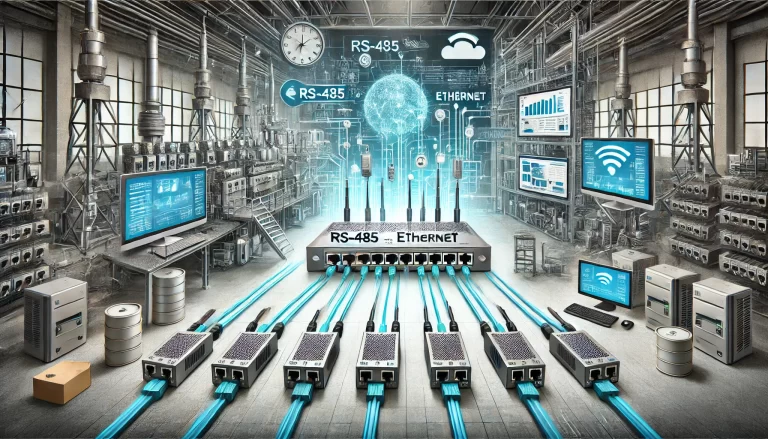In modern industrial automation, wireless technologies are playing an increasingly vital role in enabling flexible, scalable, and cost-effective communication between machines, sensors, controllers, and remote management systems. As industrial systems grow in complexity and scale, traditional wired infrastructure often becomes expensive and difficult to maintain. Wireless technologies offer a practical solution by providing mobility, ease of installation, and the ability to connect to hard-to-reach locations.
This article explores the major types of wireless communication technologies used in industrial automation, their technical characteristics, advantages, limitations, and best-fit application scenarios.
1. Overview of Wireless Technologies in Industry
| Technology | Frequency Band | Typical Range | Data Rate | Key Features |
|---|---|---|---|---|
| Wi-Fi (802.11) | 2.4 GHz / 5 GHz | 30–100 meters | High (up to Gbps) | High throughput, suitable for video/data logging |
| ZigBee (802.15.4) | 2.4 GHz | 10–100 meters | Low (250 kbps) | Mesh support, low power, simple sensor data |
| Bluetooth / BLE | 2.4 GHz | 5–30 meters | Medium (1–2 Mbps) | Point-to-point, low energy, short range |
| LoRa / LoRaWAN | Sub-GHz (433/868 MHz) | Up to 10+ km | Very Low (kbps) | Long range, low bandwidth, ultra-low power |
| NB-IoT / LTE-M | Licensed Cellular | National scale | Low–Medium | Remote monitoring, wide area |
| WirelessHART | 2.4 GHz | 30–100 meters | 250 kbps | Industrial-grade, reliable, time-synchronized |
| ISA100.11a | 2.4 GHz | 30–100 meters | 250 kbps | Advanced control, interoperability |
| 5G URLLC | Sub-6 GHz / mmWave | 100–500 meters | Ultra High (Gbps) | Ultra-reliable low latency, real-time control |

2. Detailed Analysis of Major Wireless Technologies
Wi-Fi (IEEE 802.11)
Strengths: Offers high data rates suitable for transferring logs, images, or video streams. Infrastructure is widely available and supported by most devices.
Weaknesses: Susceptible to interference in industrial environments; not optimized for real-time or low-latency control.
Best Use Cases: Industrial office Wi-Fi, control room terminals, portable operator panels.
ZigBee (IEEE 802.15.4)
Strengths: Designed for low-power sensor networks with mesh capabilities. Self-healing networks increase reliability.
Weaknesses: Limited data bandwidth, not suitable for high-speed control or video.
Best Use Cases: Distributed sensor networks, temperature/humidity monitoring, smart lighting.
Bluetooth and BLE (Bluetooth Low Energy)
Strengths: Low power consumption, point-to-point or short-range mesh networks, suitable for handheld or wearable industrial tools.
Weaknesses: Short communication distance and limited device connections.
Best Use Cases: Wireless configuration of instruments, mobile operator interfaces, machine diagnostics.
LoRa / LoRaWAN
Strengths: Very long-range communication (up to 10 km in open areas), extremely low power use, ideal for remote sensor deployment.
Weaknesses: Very low data rates; best for periodic or small data packets.
Best Use Cases: Water and gas metering, remote oil/gas site monitoring, agriculture automation.
NB-IoT / LTE-M
Strengths: Use of mobile networks enables deployment without local infrastructure. Supports roaming and deep indoor penetration.
Weaknesses: Dependency on mobile operators, not ideal for mission-critical control tasks.
Best Use Cases: Smart meters, citywide asset tracking, remote alarms.
WirelessHART
Strengths: Tailored for industrial process control; deterministic communication; mesh topology; robust against interference.
Weaknesses: Higher cost and complexity; limited bandwidth.
Best Use Cases: Chemical plants, oil refineries, pharmaceutical production lines.
ISA100.11a
Strengths: Designed for process automation with support for complex traffic, high security, and interoperability with other protocols.
Weaknesses: Niche technology with fewer vendor options than WirelessHART.
Best Use Cases: Industrial automation needing reliable wireless control and real-time data acquisition.
5G URLLC (Ultra-Reliable Low Latency Communications)
Strengths: Offers unprecedented low latency (~1 ms), extremely high bandwidth, and ability to connect thousands of devices.
Weaknesses: Requires significant infrastructure investment and still under global rollout.
Best Use Cases: Factory automation, AGVs (Automated Guided Vehicles), remote robotics, augmented reality maintenance.

3. Application Mapping and Technology Selection Guide
| Industrial Application | Recommended Wireless Technology | Reason |
|---|---|---|
| High-speed data collection | Wi-Fi, 5G | High bandwidth needed for logs/video |
| Environmental monitoring | ZigBee, LoRa | Low power, battery-powered mesh networks |
| Remote equipment monitoring | NB-IoT, LoRa | Wide-area, occasional reporting |
| Safety-critical control | WirelessHART, ISA100, 5G URLLC | Low latency, high reliability |
| Equipment configuration/diagnostics | Bluetooth, BLE | Short-range, simple pairing |
4. Future Outlook and Trends
Convergence of IT and OT: As more industrial systems migrate toward digital transformation, wireless technologies are serving as a bridge between Operational Technology (OT) and Information Technology (IT).
Private 5G networks: Emerging as a powerful solution for large industrial campuses needing real-time control with low latency and data isolation.
Hybrid networks: Combining multiple wireless technologies (e.g., LoRa for sensor data + 5G for command/control) is becoming more common.
Cybersecurity focus: Wireless networks in industry require robust encryption, authentication, and monitoring to prevent intrusion.

Conclusion
Wireless technologies are revolutionizing the landscape of industrial automation. By understanding the capabilities and limitations of each communication protocol, engineers and integrators can design smarter, more adaptive systems tailored to their specific industrial environment. From sensor networks in remote oilfields to real-time robot coordination on factory floors, the future of wireless in automation is not just promising—it’s inevitable.
